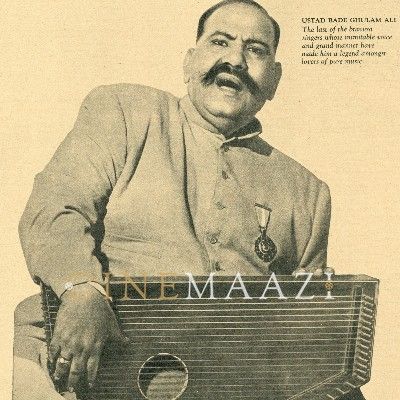Bade Ghulam Ali Khan

Subscribe to read full article
This section is for paid subscribers only. Our subscription is only $37/- for one full year.
You get unlimited access to all paid section and features on the website with this subscription.
Not ready for a full subscription?
You can access this article for $2 , and have it saved to your account for one year.
- Born: 2 April, 1902 (Kasur, Punjab, British India)
- Died: 25 April, 1968 (Hyderabad, Andhra Pradesh, India)
- Primary Cinema: Hindi
- Parents: Ustad Ali Baksh Khan
- Spouse: Ali Jiwai
- Children: Munawar Ali Khan
Celebrated as the ‘Tansen of the 20th century’, Padma Bhushan and Sangeet Natak Akademi Award winner Ustad Bade Ghulam Ali Khan epitomises the very cream in Hindustani classical music. To him goes credit for taking the Patiala gharana to new heights. Known for creating a unique style of his own, his manner of singing exuded a lively melodic quality. Referred to as Bade (older) Ghulam Ali Khan in order to mark him out from other maestros of the same name, he is regarded as one of the most legendary Thumri vocalists of all time. His trademark was said to be the exceptional emotional work in his singing with romance striking a dominant note, as well as his clear rendition of words. In the realm of cinema, he was convinced to render two raag-based songs for Mughal-e-Azam (1960), namely Prem jogan banke and Shubh din aayo raj dulara, for which he famously charged Rs. 25,000 per song—a lofty amount considering leading singers of the time were paid less than Rs. 5,000 per song in those days. He apparently charged this amount in an attempt to deflect other film offers that might come his way! His composition Bhor bhaye also featured in the 2009 film Delhi-6, rendered by Shreya Ghoshal and A R Rahman.
Born on 2 April, 1902 in Kasur, which belonged to the pre-Partition province of Punjab, his family hailed from descendants of the Kasur Patiala gharana. Initiated into classical music at a young age by his father, Ustad Ali Baksh Khan, who was a well-known singer himself, he was trained from the age of five by his paternal uncle, Ustad Kale Khan, who had been a court singer in the princely state of Jammu and Kashmir. He also familiarised himself with the sarangi. Having mastered the traditional style, in time, he would go on to create his own improvisations, in order to suit the tastes of contemporary audiences. His efforts resulted in the blending of four traditional styles, namely the Patiala-Kasur with elements of Dhrupad, the enhancements of Gwalior, and the intricacies of Jaipur. Taking the Thumri beyond its traditional form, he achieved enormous success with its new style. It is for this reason that he is acknowledged as a pioneering great, and one of the best of the 20th century. He was known for his gift of playing with musical notations while finding the perfect expression and melody.
He shone bright in the span of his relatively short music career. Making his mark in Calcutta in 1938 and at the All India Music Conference in Bombay in 1944, he was hailed as a master in every musical form that he explored. Captivating listeners and viewers at personal and social gatherings with his majestic performances, he was courted by the film industry but for a long time he was reluctant to render songs for films, for reasons best known to him. He eventually made just one historic exception: Mughal-e-Azam (1960). Well-known music composer Naushad managed to convince him to lend his voice for the K Asif directorial. He went on to render two classical based songs for the film, based on the raags Sohni and Rageshree. He was reportedly paid the then-whopping amount of Rs. 50,000 for his services! According to his grand daughter-in-law, Samina Ali, he charged this steep amount to ensure film projects wouldn’t come his way!
Post-Partition in 1947, he stayed on in Pakistan, as his hometown Kasur was located in the province of Punjab which fell in Pakistan. However, ten years later, he returned to India and acquired Indian citizenship with the assistance of the then Chief Minister of Bombay, Morarji Desai. Moving into his well-appointed bungalow at Malabar Hill, he travelled and lived in many cities like Calcutta and Lahore, before settling down in Hyderabad.
Among the awards he was honoured with include the Padma Bhushan - India’s third highest civilian honour, the prestigious Sangeet Natak Akademi Award, the Aftab-e Mauseeqi Award, the Sangeet Samrat Award for his contribution to the field of music, and the Sur Devta Award.
Married to Ali Jiwai, who passed away in 1932 while she was still young, their son Ustad Munawar Ali Khan would go on to become a great classical singer himself, performing widely until his demise in 1989.
Ustad Bade Ghulam Ali Khan passed away on 23 April, 1968 in Hyderabad’s Basheer Bagh Palace. He was 66. He was buried in Daira Mir Momin graveyard in the city, which is also the resting place of some prominent Sufi saints.
His grandsons Ustad Mazhar Ali Khan, Ustad Jawaad Ali Khan, Ustad Raza Ali Khan and Naqqi Ali Khan worked to keep his legacy alive. One of his pupils, Jagdish Prasad went on to become a critically acclaimed singer, while another disciple Malti Gilani founded the Bade Ghulam Ali Khan Yaadgar Sabha which keeps his music alive, attempts to provide musicians with financial assistance as well as promotes Indian classical music. A street at Basheerbagh in Hyderabad was also named after him.
In his book Thumri in Historical and Stylistic Perspectives, scholar Peter Manuel wrote, that his “vocal range and technique were extraordinary in themselves, but his greatest virtue was his brilliant sense of melody and nuance; combining these assets, he was able to take thumri to expressive heights which, in the opinion of many, have not been equalled since”.
Director Harisadhan Dasgupta made a documentary on Khan in 1968, titled Bade Ghulam Ali Khan Sahib.
References
Sources: https://www.culturalindia.net/indian-music/classical-singers/bade-ghulam-ali.html
https://theprint.in/theprint-profile/bade-ghulam-ali-khan-the-tansen-who-demanded-got-rs-25000-per-song-for-mughal-e-azam/224923/
https://www.imdb.com/name/nm0019387/
https://indiancine.ma/LAI/info






.jpg)



